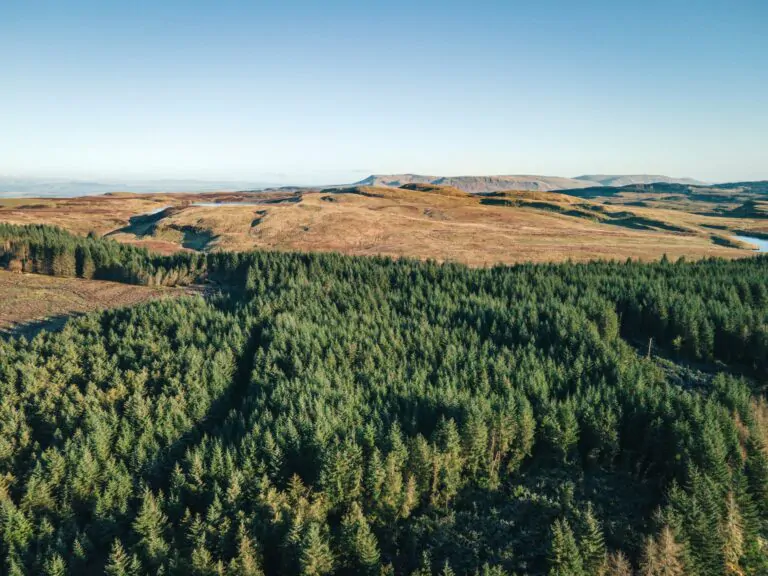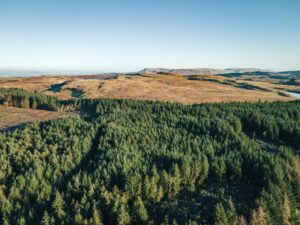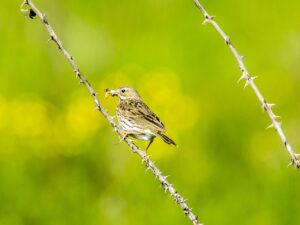The pressure to capitalise on nature


In March 2023, more than 80 organisations and academics working on climate action called on the EU to reject voluntary carbon credit schemes as a solution to the climate crisis, after it was revealed that 90% of forest carbon credits sold by the certifier, Verra, are largely worthless. These ‘phantom’ credits, which companies buy to ‘offset’ their carbon emissions rather than changing their business models, make global warming worse.
This is not news to many farming and Indigenous communities in the global south, where carbon credit schemes have been operating since at least the early 1990s. These schemes are not just flawed as climate solutions; they have perpetrated devastating human rights abuses and land grabs. In Uganda, a forest carbon ‘restoration’ scheme run by Dutch NGO Face the Future evicted thousands of people using paramilitary rangers and soldiers so the forest could be ring-fenced for carbon credits. In East Africa, pastoralist Indigenous Samburu, Borana and Rendille people are under threat from the Northern Rangeland Trust’s (NRT) carbon offset project. Community-led conservation must be embraced, and green colonialism rejected; small-scale farmers and Indigenous peoples continue to be disproportionately affected by the ‘green rush’.
In the US, carbon capture and storage, which both encourages the continuation of fossil fuel extraction and distracts from reducing emissions, is at the centre of another carbon credit scandal, with close to 200,000 credits being ‘pre-sold’ by Summit Carbon Solutions before the dubious carbon capture pipeline has even been built. Summit is trying to kick people in Iowa and South Dakota off their land who strongly oppose the project.
After decades of unregulated carbon investments, it’s increasingly obvious that offsetting is fundamentally flawed, and enables companies to market their products or services as ‘carbon neutral’ without making carbon reductions in their day-to-day operations. Offsetting threatens, and has already caused, a new wave of land grabs and violent evictions in order to turn nature and soil carbon into financial assets.
Carbon is complex
Although UK farmers are not facing direct dispossession or land-grabbing, they might be facing a loss of autonomy. The displacement of food production by carbon and biodiversity offsets could make farmers mere agents for those wishing to greenwash their activities rather than undertake transformative change.
Farming carbon instead of producing food could see UK farmers locked into long contracts, and out of their land, for 30 years or more – but carbon needs to be stored for at least 100 years to make a difference to global warming. Although carbon can be measured, it’s complex and changeable. And the idea that the carbon emitted by burning fossil fuels, which will stay in the atmosphere for thousands of years, is analogous to biological carbon stored in trees, for example (which may have a short life span for a variety of natural and commercial reasons), is an opaque ploy used by proponents of offsetting to make carbon credits attractive.
Carbon and biodiversity credits have been sold as a simple solution to a complex problem, and they allow corporates to continue emitting – one reason why a green marketing gloss is usually required. Nature is complex and can’t be measured in a way that fits the prevailing economic or political paradigms.
Complexity is inherent and necessary
The phrase ‘nature-based solutions’ is used as a catch-all to describe the many roles that nature ‘performs’, which we have too often either forgotten about or eradicated in some way. It was thought up by conservationists to make nature more attractive to economists and politicians and has helped (inadvertently or otherwise) to move nature towards the balance sheet. We should reclaim it.
In farming, genuine nature-based solutions include improving soil health, encouraging pollinators, managing pests and diseases without using chemicals, and increasing the diversity of crops. All of which requires farming to move towards agroecological systems – farming with, instead of against, nature.
Private investment could bring a dangerous and as yet barely regulated dynamic to the scenario, where profit becomes the main driver. It overlooks the inherent and necessary complexity of ecology. How do you measure the fluctuations of carbon in soil? The benefits of billions of soil microorganisms and their interactions and interconnections that science has only scratched the surface of?
Meanwhile, land will be taken out of food production at a time when we need to be building local resilience and short supply chains to counter climate shocks and food insecurity. Some estimates say global food prices could go up 80% by 2050 if forest carbon credits are overused.
The ‘green rush’ in Scotland
There are now close to 800 carbon investment projects in Scotland. Land is being bought for carbon storage; large companies and landowners have the financial muscle to purchase big swathes for tree-planting and peat restoration, pushing land prices up. Often, the buyers don’t live in Scotland. In Perthshire, 10,500 acres of land has just gone on the market for offers over £105 million.

Crofters are worried about big companies exploiting the land for carbon credits, and communities are calling for recognition of crofting as ‘a template for people in nature’. They are asking for support to make informed decisions about carbon, and have suggested that local people could learn how to do carbon audits (The Crofter, Dec 2022, p3). The Scottish Land Commission is now warning that family farms and local communities are being shut out of the rural land market. In a new discussion paper for Community Land Scotland, Alastair McIntosh warns the carbon rush could ‘land Scotland’s rural communities with a fresh driver of upheaval, disempowerment and depopulation’.
Nature has always been interwoven with traditional farming practices, like grazing cows on the machair of the north-west coasts of Scotland and Ireland which produces spectacular floral diversity. You could call these types of practices nature-based solutions; crofters know it as life. Supporting and preserving local knowledge and encouraging a younger generation to take up farming with low inputs in a nature-friendly way is vital not only in mitigating the climate crisis, but also in creating a social and ecological future where diversity thrives.
Cold calls in Wales
The Welsh government says that reducing emissions must be the priority for all farms and businesses. It suggests farmers use the Woodland Carbon Code when entering into offsetting arrangements. The government says it ‘does not support schemes that do not adhere to the internationally recognised standards for carbon markets’, but there is currently little regulation in place to stop bad actors.
Welsh farmers have been cold-called by investors wanting to buy their land to plant it up for woodland carbon credits – credits which could be bought by any corporate interest looking to ‘green up’ their appearance. In Powys, farmers report being priced out of the market, as land is bought up for tree-planting by outside investors, including a steel manufacturer wanting to offset their emissions.
‘Development’ in England
The pressure to financialise nature requires us to forget about nature’s intrinsic value, and to try to assign a monetary value to it instead. In England this means imagining that habitats which have emerged over decades or centuries can be recreated elsewhere, to ensure ‘no net loss’ of biodiversity, or biodiversity ‘net gain’ (BNG).
The idea is fundamentally flawed from an ecological point of view: ecosystems that have developed their unique and intricate balance of plants, birds, mammals, invertebrates and fungi over time, once lost, cannot be recreated, no matter how attractive the sales pitch makes the mitigation measures sound. Added to that, the carbon these habitats store is emitted when they are destroyed.
A prime example of this is the High Speed 2 rail project. By selling the idea of mitigation in the form of ‘no net loss’, developers sought to allay concerns that nature is being obliterated. It essentially boils down to a PR exercise: yes, we are destroying this ancient woodland, but we’ll plant some new trees up the road to make up for it. The idea that the interconnected nature of a woodland where species have co-evolved and co-existed for hundreds of years can be adequately replaced in our lifetimes is offensive, and fundamentally wrong.
Not surprisingly, HS2 Ltd has been undervaluing existing nature and overvaluing its compensation measures. There will be nearly eight times more biodiversity loss than HS2 Ltd accounted for. They left out watercourses, ponds and trees; well-established species-rich hedgerows were valued lower than the new hedgerows they plan to plant.
Investors in natural capital are not likely to be looking to help maintain existing biodiversity on farms, or anywhere else. What does this mean for all those who have been practicing nature-friendly farming for decades? It means no money for protecting places already rich in wildlife. Degraded arable land has the most to gain in this equation. Farmers would have to plough up established, species-rich meadows in order to get the money to then restore them.

Nature markets
There are now calls for better regulation to ease the path of new markets for nature in the UK. How will small-scale farmers fare? It’s difficult to see how they will flourish. The post-Brexit farming system is scrapping subsidies to farmers doing good work, and moving them across to larger farms which have intensified. The small and medium-sized farms, the best for biodiversity, are being forced to intensify to fill the subsidy gap, or are giving up. Nature markets will allow corporations to continue to offset their harmful practices. They are also highly complex mechanisms. Where does the power lie between farmer and investor, and who will own the data? Inevitably, that relationship will be extractive.
Offsetting is a huge distraction then, when we should be turning our attention to limiting the damage done in the first place, transitioning from fossil fuels and encouraging and investing in those farming practices which will be the only way forward in the face of climate breakdown. While we continue to operate within an economic system that will not stop growing, small-scale farmers and Indigenous people who are the protectors of 80% of the world’s biodiversity rely on intergenerational ecological knowledge to live within the planet’s limits. Moving away from corporate-controlled industrial-scale farming is imperative, as is the rejection of solutions that seek to perpetuate a broken system.
Investment must focus on those practices that address as a whole the polycrisis we now face across food, climate, biodiversity and health, and it should be at the grassroots level. Money should be flowing directly to people and communities building a local food system with circular economy thinking, and driven by the principle that everyone has the right to good food. Low input agroecological farming is the best hope of building resilience, in the face of future shocks.
The complexity of life does not lend itself to a simple market equation. Trying to shoehorn the unknowable intricacy of ecological processes into a one-size-fits-all table of solutions to be invested in feeds a flawed economic system and starves nature of its intrinsic, complex and priceless value. Put a price on nature and some will be quick to say it’s not worth much.
Source
Language of the news reported
Related content:
Copyright © Source (mentioned above). All rights reserved. The Land Portal distributes materials without the copyright owner’s permission based on the “fair use” doctrine of copyright, meaning that we post news articles for non-commercial, informative purposes. If you are the owner of the article or report and would like it to be removed, please contact us at hello@landportal.info and we will remove the posting immediately.
Various news items related to land governance are posted on the Land Portal every day by the Land Portal users, from various sources, such as news organizations and other institutions and individuals, representing a diversity of positions on every topic. The copyright lies with the source of the article; the Land Portal Foundation does not have the legal right to edit or correct the article, nor does the Foundation endorse its content. To make corrections or ask for permission to republish or other authorized use of this material, please contact the copyright holder.
